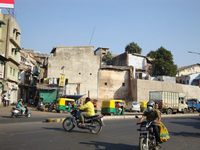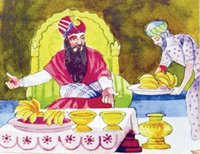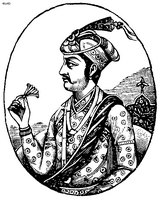Historical Glimpses
Ashaval
Existence of Ashawal is traced way back in 9th - 10th century uptill 13th century. The estimated area of Ashawal was from Calico Mills via Jamalpur Darwaja upto Astodia Darwaja. The hillock near Astodia Darwaja (the present Dhal-ni-pol area) was known as 'Asha Bhil-no-Tekro'.
Karnavati
The historical references show that King Karnadev Solanki conquered Ashaval in 1074 and established the Town Karnavati. Karnamukteshwar Mahadev, outside Sarangpur Darwaja, is believed to be constructed by Karnadev.
Ahmedabad
After Sultan Ahmed Shah ascended the throne, he went upto Bharuch in south Gujarat to curb the rebels. While returning he halted at Ashaval. He liked the city for its central location in Gujarat as well as its proximity to sea shore and ports. So he decided to make it as his capital.Before finalizing it, he sought permission of Prophet AL-Khijar through his preceptor Saint-Shaikh Ahmed Khattu Ganjbaksha of Sarkhej.
According to his advice, the foundation stonelaying ceremony at his palace was performed on 26th February 1411. For this purpose, four persons, Sultan Ahmed Shah himself, Ahmed Khattu Ganjbaksh, Kazi Ahmed and Malik Ahmed held the ends of the string from four directions. Thus, the construction of the Royal Palace started and Ahmedabad was established. After giving poison to his grandfather under the impact of back biting, Ahmed Shah repented a lot and he transformed himself and became pious. Later he proved himself as one of the best rulers. The name of Sultan Qutubuddin is associated with Kankaria Lake.
As Sultan Muhammad Shah conquered two forts namely Junagadh and Pawagadh, he was infamed as 'Muhammad Begado'. He had build a wall around the city and Darwajas to make it safe and good looking.
The Mughal period in Gujarat started in 1572 with Badshah Akbar. Because of the rebellions, Akbar had to come to Gujarat. Jahangir did not like Ahmedabad but he had stayed in Ahmedabad for nine months. Motishahi Palace was built during the rule of Shah Jahan (1618-23). Now it is known as Shahibaug Palace.
Ahmedabad came under the Maratha rule in 1753. A political treaty was signed between the Marathas and Gaekwad about the sharing of administrative responsibility.
John Andrews Dunlop, the collector of East India company, took possession of the city in June 1818 and the Union Jack of the British rule was hoisted on bhadra Fort. Mr. Dunlop, the collector started taking care of law and order during the British rule. The industrial revolution had started in the city during the British rule and the prosperity of the city in 1894 at the cost of Rs. 8000/- The Britishers constructed Ellisbridge and exhibited their architectural skills.
The services of railway, electricity, telephone and post were also made available during the British rule. The English education also began by them.
Justice Loving Sultan
It is said that the son-in-law of Ahmed Shah murdered somebody in the fit of arrogance when he was young. The Sultan got him arrested and sent to Kazi for his trial. In order to avoid Sultan's displeasure, the Kazi ordered that the accused should give 22 gold coins to the successors of the dead as a punishment. When the Sultan learnt about it, he felt that any wealthy person can take the undue benefit of such judgement. He considered the judgement as unjust. Therefore, he reviewed the case of his son-in-law and sentenced him to death by hanging and asked the hangmen to keep the dead body hanging for twenty four hours, so that people could see the consequence of killing someone and also know the impartiality of the Sultan. Such was the Sultan's love for justice.
Like Cures The Like
During Mughal era, political murders were predominant. Muhammad Begada's mother developed a phobia that somebody will poison his son. She knew the principle of "Like cures the like". So she started giving poison in small quantity to Muhammad since his childhood. Slowly, she increased the dose so that he could digest poison of any kind in future. To stop side effects,Muhammad was given food in larger quantity. As a result, the food he consumed daily was huge. He needed food the moment he got up from his bed. So the dishes were kept ready near the bed before he got up.
Jahangir and Sir Thomas Roe
One political event during the rule of Jahangir is well known. The first meeting between Sir Thomas Roe, an Ambassador of King James of England and Jahangir was arranged in 1618 at Ahmedabad. Jahangir issued permit for trading to East India Company in India. Jahangir had no vision that he was making a smooth way for the British to unfurl the Union Jack on Bhadra Fort after 200 years i.e. in 1818, by issuing the permit of trading.
Zaverimama
It is said that Jahangir, the emperor of Delhi, addressed Shantidas Zaveri as �Zaverimama�.�Mama� means maternal uncle. You may wonder how Shantidas was Jahangir�s maternal uncle!
Shantidas used to visit Akbar�s court in Delhi for trade in jewels and diamonds. Thus, he came into contact with Jodhabai, the Hindu begum of Akbar. Both Jodhabhai and Shantidas belonged to Marwar. So Jodhabai addressed Shantidas as �brother� and gave him respect in that way.
Once there was a difference in opinion on some issues between Akbar and Jodhabai. Feeling offended, Jodhabai came Ahmedabad and stayed at the Haveli of Sheth Shantidas Zaveri. Prince Jahangir came to Ahmedabad after Jodhabai�s two month�s stay in Ahmedabad. At that time Jodhabai introduced Shantidas to her son as his maternal uncle, Mama. Since then Shantidas began famous as Zaverimama in the court of Delhi. Akbar instructed Ajamkhan, the Suba of Ahmedabad (1635-1642) to appoint him as the �Nagarsheth� of Ahmedabad. Thus, not only Shantidas, but his successors also enjoyed the status of Nagarsheth during that period.
Saduba Episode
Raghu Ramchandra, the Governor Suba during the Maratha period was a gullible person. He could easily be misled. People called him a �Deaf Governor�. The backbiters around him used to inform him about the wealth and prosperity of the citizens of Ahmedabad. On that basis, the Governor used to collect toll from the people.
A backbiter named Otiya, once informed the Governor that a woman called Saduba, the wife of a bard had illicit relations with some other person. The Governor sent his guards to present Saduba before him. Saduba asked her husband to behead her in order to prevent defamation. Therefore, as per the advice of his wife, the bard cut off Saduba�s head to save themselves from defamation. This event made the bards furious. They planned for giving a lesson to Otiya. For this, they hung the dead body of Saduba�s on a neem tree. Now they demanded the Governor to prove the rumours about Saduba character. Sensing the gravity of the matter, Otiya was handed over to Bards and they killed him by pelting stones at him.
The English officer Balentine was shocked by this event.
The local people constructed a temple in the memory of Saduba in Shahpur area, which is known as Saduba-ni-Pol.
A Bird in Hand is Better than Two in a Bush
Karsanrao Bhimrao Shelukar was appointed as the Governor of Peshwas in 1798. He was cruel by nature and a tyrant; but he was romantic at heart. The people of the state hated him for his bad administration. Even the Peshwa was unhappy with him. In order to drive away Gaekwad from the city, he attacked the palace of Gaekwad and took over its possession. He prevented the message to be known to Gaekwad in Baroda.The matter was kept secret for few days. One day, the supporters of Gaekwad persuaded a Brahmin to carry a letter to Gaekwad containing all the details of the event secretly by hiding it in his innerwear. When the letter was delivered to Gaekwad, he came to know everything. He then informed the Peshwas about it and made such an arrangement that Shelukar may be arrested and sent to Pune. He asked Peshwa�s permission to arrest Shelukar.
Gaekwad sent his troops to Ahmedabad under the commandership of the Governor Shivram Gardi. When the troops of Gaekwad reached Ahmedabad, Shelukar was busy enjoying a musical evening. When the reports about the troops of Gaekwad reaching Ahmedabad were given to him, he did not pay any serious attention to the matter. The troops entered the city through Jamalpur Darwaja. When the troops proceeded further Shelukar ordered to close all the doors of Bhadra. The troops of Shelukar confronted Gaekwad�s army at Teen Darwaja. But the Shelukar�s supporters betrayed him. The troops led by Shivram entered the Bhadra Darwaja via the present Karanj Police Station. The commander of Gaekwads troops took with him about a hundred soliders and raided the place where Shelukar was enjoying the musical party. He showed him the letter of the Peshwa giving permission to arrest Shelukar. Shelukar was arrested and was kept in the prison in Ahmedabad for sixteen days. Then he was sent to Pune. Though Shelukar had a large army, he was defeated because he was engrossed in luxury. People still remember the incident and recall it by singing a song in the vernacular language - �Hathman dando Bagalman moyi, Haveli letan Gujarat Khoyi.�









